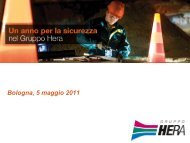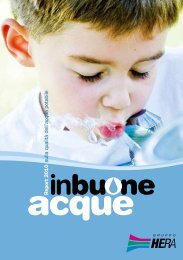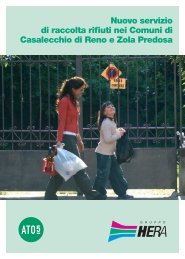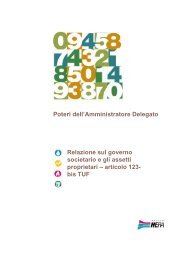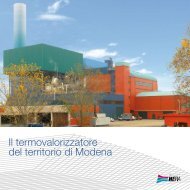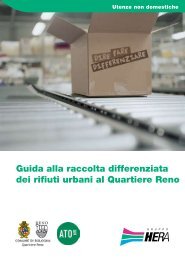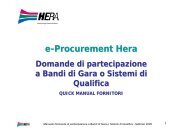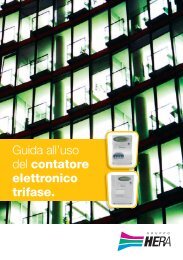I termovalorizzatori del Gruppo Hera - Il Gruppo Hera
I termovalorizzatori del Gruppo Hera - Il Gruppo Hera
I termovalorizzatori del Gruppo Hera - Il Gruppo Hera
Create successful ePaper yourself
Turn your PDF publications into a flip-book with our unique Google optimized e-Paper software.
Un impianto cresciuto insiemeal territorioL’impianto oggi<strong>Il</strong> sito su cui sorgel’impianto è certificatoper la qualità (ISO9001) dal 2004,mentre la nuova linea<strong>del</strong> termovalorizzatoreè certificata ISO14001 dal 2009 edè in corso l’istruttoriaper l’ottenimento <strong>del</strong>laregistrazione EMAS.Inizio anni ’70: il Comune di Forlì decide di modernizzare il propriosistema di smaltimento dei rifiuti urbani realizzando un impiantodi incenerimento, inserito nell’area integrata per la gestione <strong>del</strong>la raccoltae <strong>del</strong>lo smaltimento dei rifiuti di via Grigioni 19. È dotato di forni a grigliaVon-Roll, caldaie a tubi di fumo ed elettrofiltro, oltre che di un sistemadi recupero <strong>del</strong> calore per il riscaldamento dei locali <strong>del</strong>la sede e <strong>del</strong> limitrofodepuratore <strong>del</strong>le acque reflue urbane.1987-88: il sistema di recupero termico viene potenziato, collegandoun sistema di teleriscaldamento invernale di un limitrofo impianto di serreper la coltivazione di piante ornamentali. Complessivamente la potenzatermica nominale raggiunta è di 3,5 milioni di kcal/h. In questi anni lanuova normativa di settore impone un potenziamento degli apparatiantinquinamento.1994: si installa il Sistema di Monitoraggio in Continuo <strong>del</strong>le Emissioni(SMCE)2000: la sempre maggiore attenzione agli impatti ambientali portaa un ulteriore abbassamento dei limiti di emissione e al miglioramento<strong>del</strong>l’efficienza energetica. <strong>Il</strong> Consorzio Intercomunale Servizi, subentratoal Comune nella proprietà <strong>del</strong>l’impianto, installa un impianto di produzionedi energia elettrica e inserisce nuovi sistemi per migliorare l’abbattimentodegli Ossidi di Azoto (sistema SNCR a urea), <strong>del</strong>le polveri (filtro a manichein coda), dei microinquinanti organici (sistema a iniezione di carbone attivocon supporto di calce).L’impianto, oltre a smaltire circa 45.000 tonnellate all’anno di rifiuti,è ora in grado di produrre energia elettrica per circa 13.000 GWh/anno.Viene ultimato l’impianto di preselezione meccanica dei rifiuti che, trattandoi flussi in ingresso, separa la frazione umida da quella secca destinataalla termovalorizzazione, migliorando la qualità <strong>del</strong>la combustione.All’approssimarsi dei trent’anni di servizio, le vecchielinee di incenerimento 1 e 2, pur adeguate allenormative, risultavano ormai insufficienti per soddisfarela domanda di smaltimento proveniente dal territorioforlivese, oltre ad essere energeticamente pocoefficienti. All’inizio degli anni 2000, con la nascita di <strong>Hera</strong>S.p.A., prese avvio la progettazione e la realizzazione<strong>del</strong>la nuova linea 3, avviata a luglio 2008. Con unapotenzialità nominale di smaltimento paria 400 tonnellate al giorno, la nuova linea alimentaLa nuova linea è dotata di un moderno sistemadi trattamento fumi totalmente a secco a doppiostadio e doppio sistema di abbattimentodegli Ossidi di Azoto (sistema SCNR + siatema SCRad ammoniaca) che consentono di ottenere un impattoambientale di gran lunga inferiore a quello <strong>del</strong>levecchie linee, pur smaltendo più <strong>del</strong> doppio dei rifiuti.Le linee 1 e 2 sono state dismesse a fine 2008, pocodopo la messa in esercizio <strong>del</strong>la nuova linea 3.1987-1992: l’installazione di nuove caldaie a tubi di acqua insostituzione <strong>del</strong>le precedenti a tubi di fumo, consente la realizzazione<strong>del</strong>la camera di post-combustione prescritta dalla normativa e la futurainstallazione di un turboalternatore per il recupero di energia elettrica.Si realizza anche un nuovo sistema di abbattimento degli inquinanti,costituito da torre di lavaggio ad umido, con il relativo trattamento<strong>del</strong>le acque di processo.un sistema di recupero energetico da 10 MW elettriciad alto rendimento (più <strong>del</strong> doppio <strong>del</strong> vecchio impianto).È inoltre quasi ultimato un sistema di recupero termico<strong>del</strong> calore di ulteriori 20 MW termici a servizio <strong>del</strong>la retedi teleriscaldamento pubblica.The plant site wasawarded qualitycertification (ISO 9001)in 2004, whilst thenew waste-to-energytreatment line wasawarded ISO 14001certification in 2009 andis currently applying forEMAS registration.2001: si attiva un collegamento modem che rilancia i dati <strong>del</strong>le emissionirilevate dallo SMCE direttamente alle sedi degli Enti di controllo (ARPAE Provincia), che possono accedervi in qualsiasi momento.A plant that hasgrown togetherwith the areaEarly 1970s: the town of Forlìdecides to modernise its urbanwaste disposal system, buildingan incineration plant at 19 ViaGrigioni to handle the collectionand disposal of waste. It has aVon-Roll grate furnace, gas pipeboilers and electro-filters, aswell as a heat recovery systemfor heating the premises and aneighbouring urban waste waterpurification system.1987-88: the heat recoverysystem is expanded byconnecting a winter districtheating system from a nearbynursery’s greenhouses wherethey grow ornamental plants. Atotal rated heating power of 3.5million kcal/h is reached. Newindustry regulations mean thatthe pollution control system hasto be upgraded.1987-1992: the installationof new water pipe boilers toreplace the old gas pipe boilersallows the installation of theregulatory post-combustionchamber and the futureinstallation of a turbo-alternatorfor the recovery of electricity.A new system for reducingpollutants is also installed,comprising a washing towerwhere the process water istreated.1994: the Continuous EmissionMonitoring System is installed2000: growing awareness of theimpact on the environment leadsto a further reduction in emissionslimits and an improvement inenergy efficiency. The JointMunicipal Services Consortium,which took over ownership ofthe plant from the town council,installs an electricity generatingplant and new systems forimproving the reduction ofnitrogen oxides (urea SNCRsystem), particulates (bag filters),organic micro-pollutants (activatedcarbon and lime injection system).In addition to treating around45,000 tonnes of waste per year,the plant now has the capacity togenerate about 13,000 GWh/yearof electricity.The mechanical waste preselectionsystem, which separateswet waste from the dry wastedesignated for waste-to-energytreatment, thereby improvingthe quality of the combustion, iscompleted.2001: a modem connection isset up to send all emissionsdata recorded by the CEMSdirectly to the supervisoryauthority (regional environmentalprotection authority andprovincial council), which canaccess the data at any time.The plant todayGetting on for thirty yearsof service, the old incinerationlines (1 and 2), while stillcomplying with regulations,are no longer able to satisfydemand from the Forlì area,as well as not being very energyefficient. At the beginningof the 2000s, the foundationof <strong>Hera</strong> S.p.A. saw the designand construction of a thirdline, which came into servicein July 2008. With a ratedwaste disposal capacity of 400tonnes per day, the new lineprovides the power for a highperformance10 MW energyrecovery system (more thantwice that of the old plant).A heat recovery system ofa further 20 MW, servicing thepublic district heating network,is also near to completion.The new line is equipped witha modern two-stage completelydry gas treatment system anda dual system for the reductionof nitrogen oxides (SCNR + SCRwith ammonia) which have asignificantly lower impact onthe environment that the oldlines and treat more than twicethe amount of waste.Lines 1 and 2 were shut downat the end of 2008, shortlyafter the new line, 3, came intoservice.80 | I <strong>termovalorizzatori</strong> <strong>del</strong> <strong>Gruppo</strong> <strong>Hera</strong> | L’impianto di Forlì hera group’s waste-to-energy plants | The forlì plant | 81




